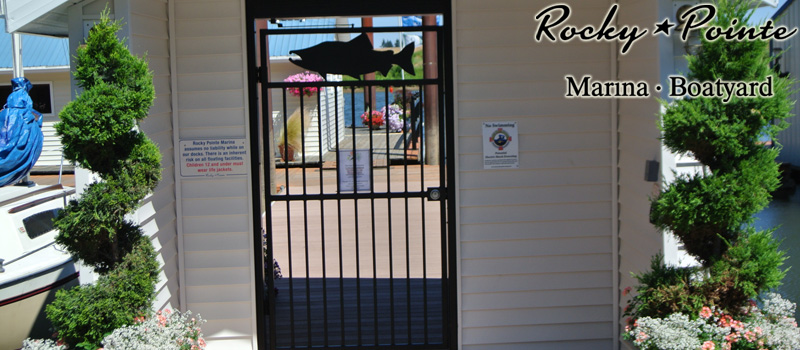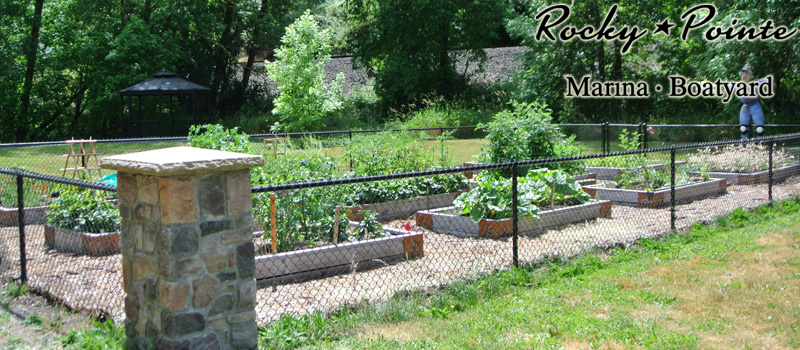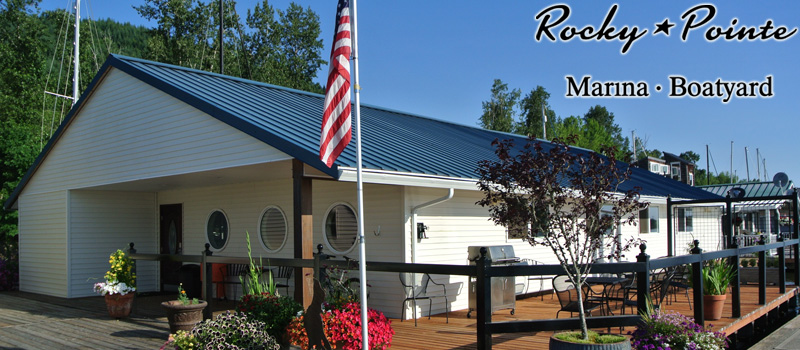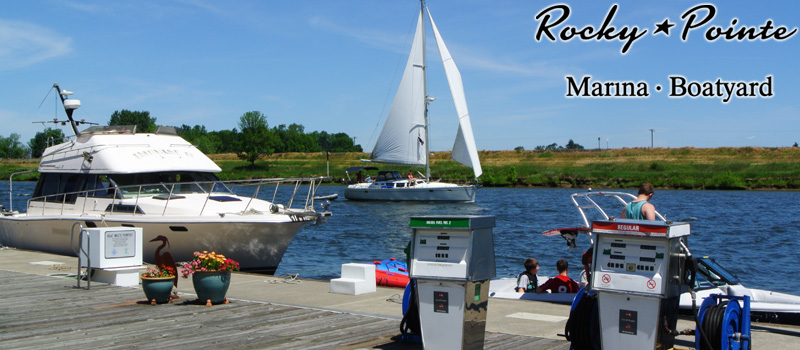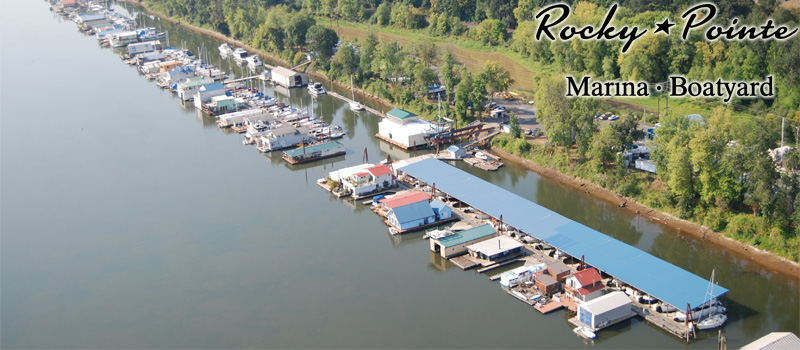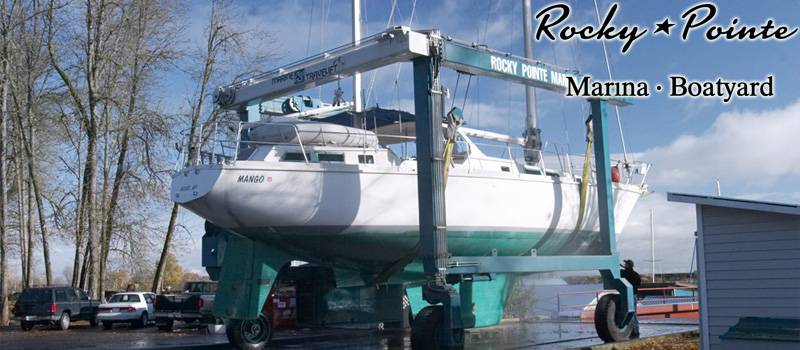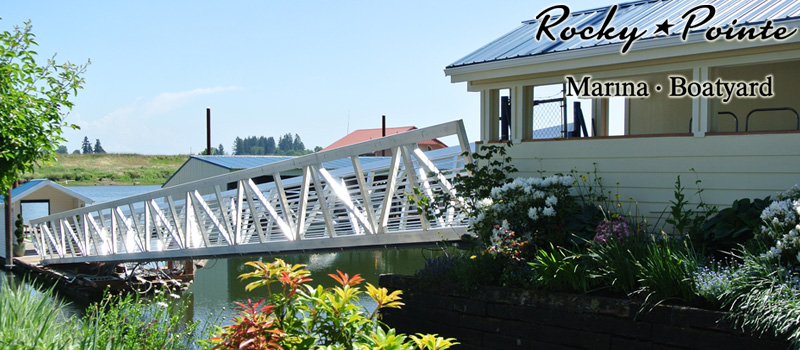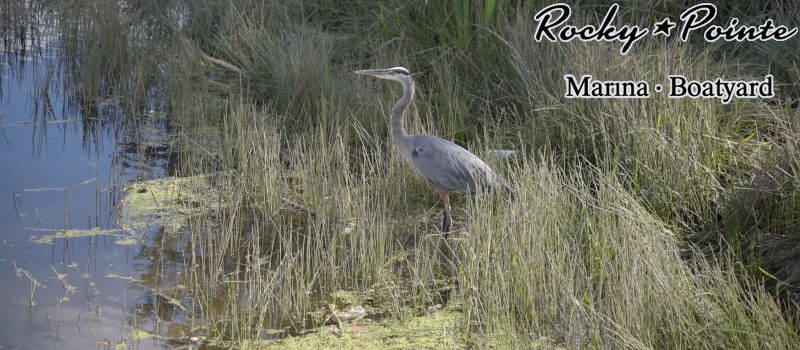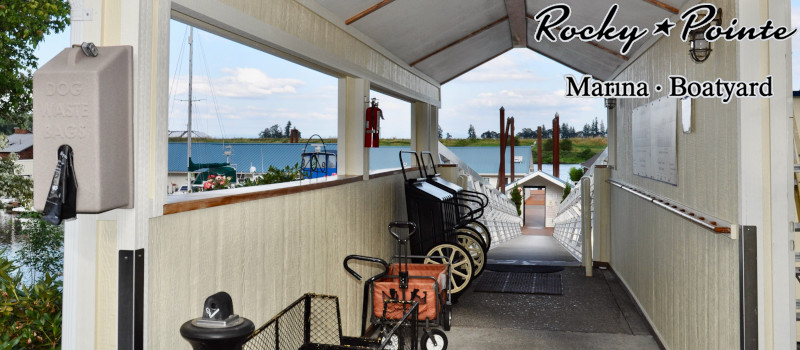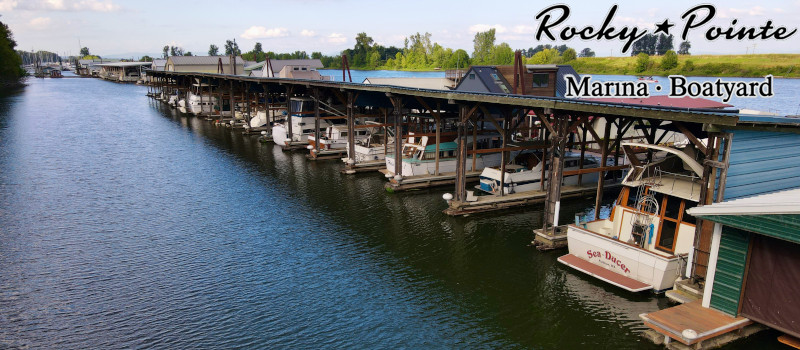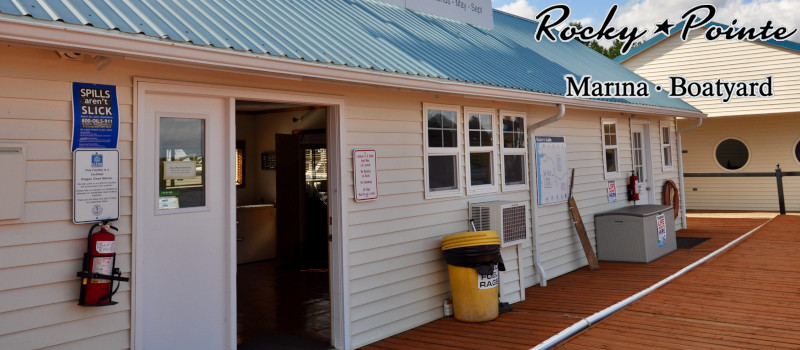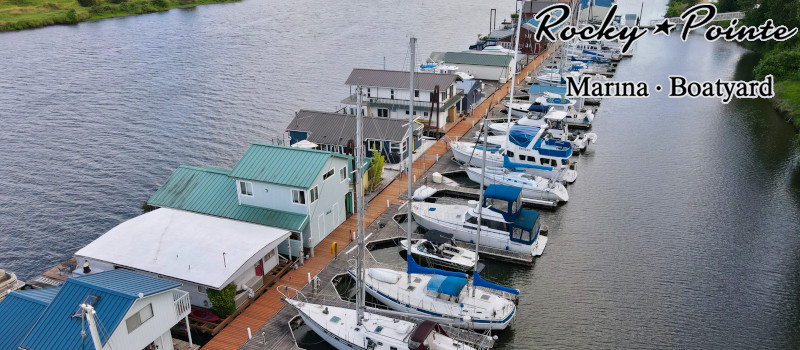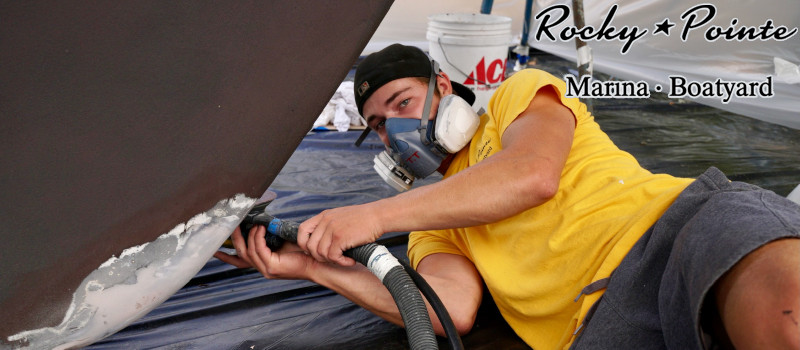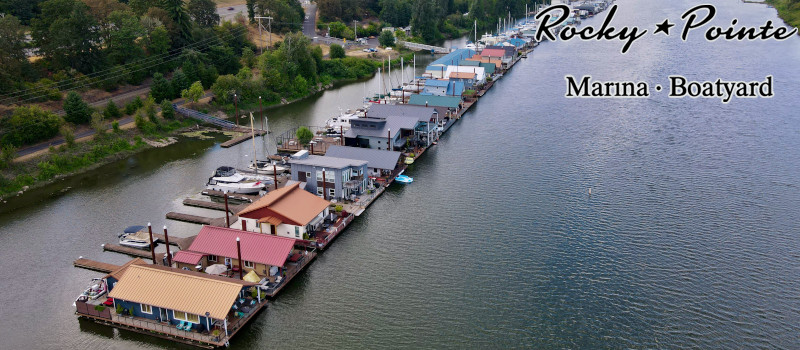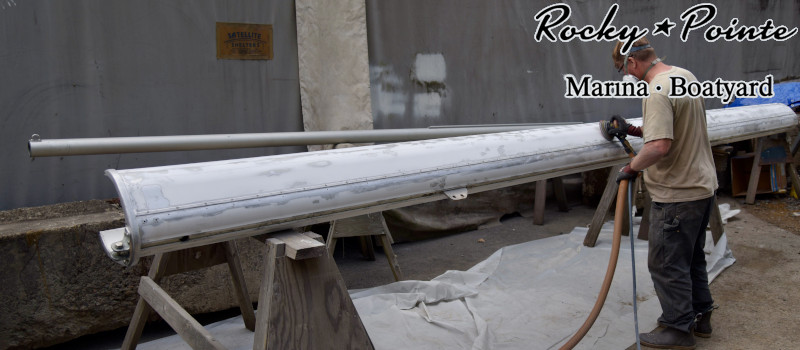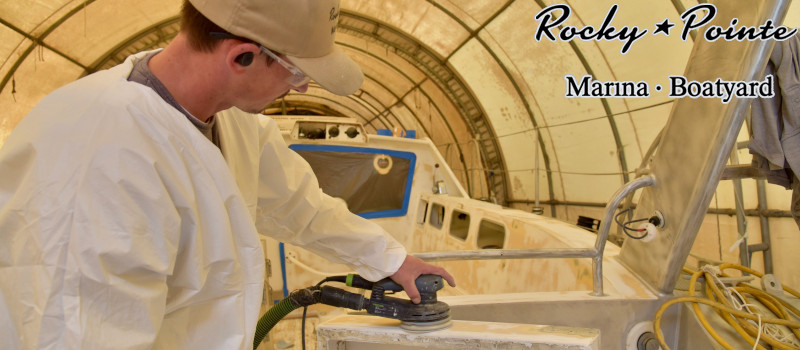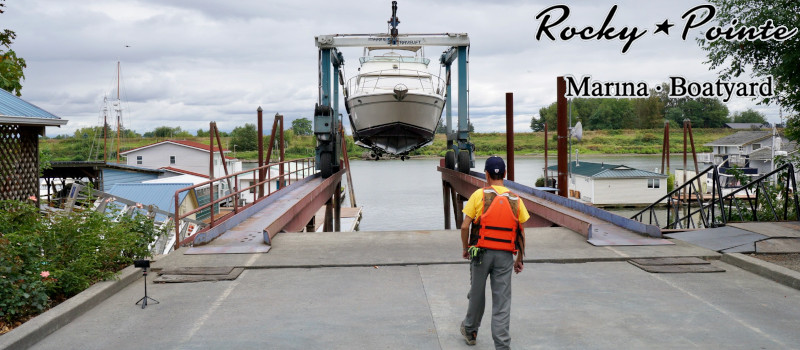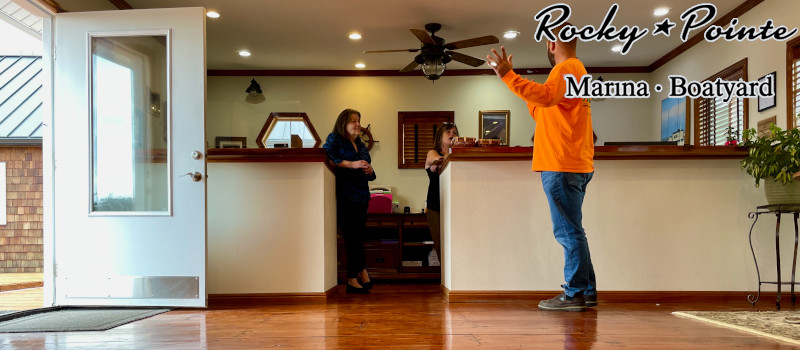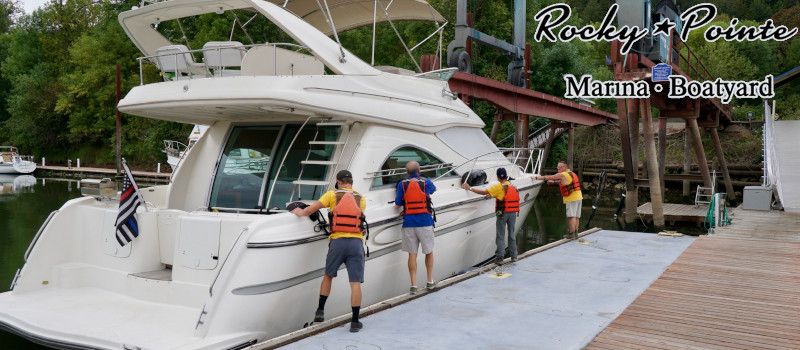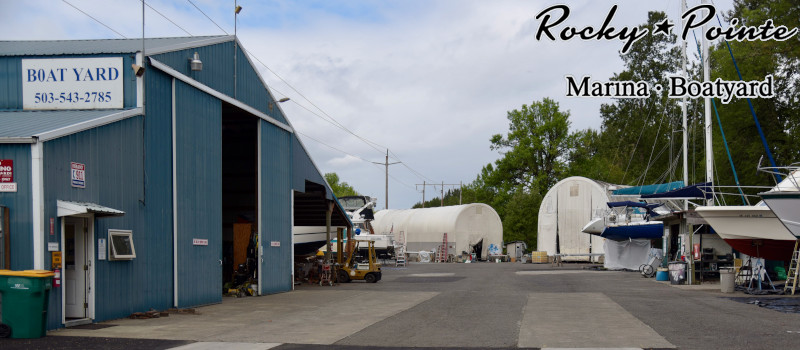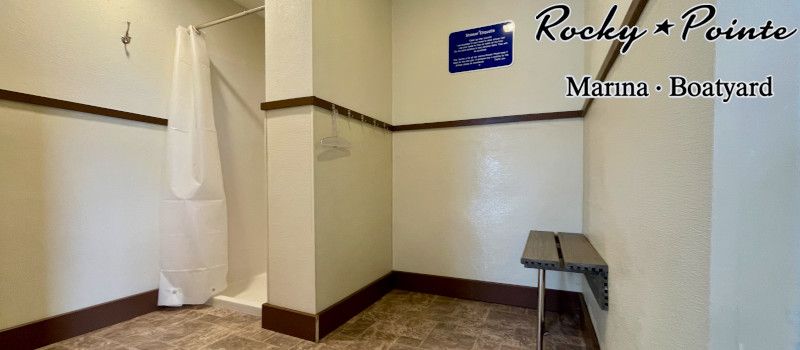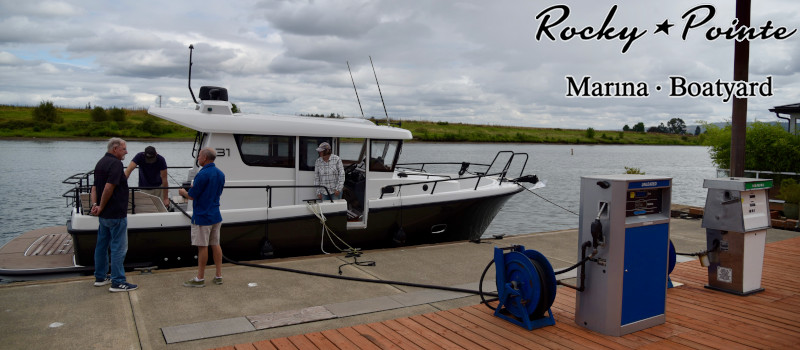Rocky Pointe Marina – History
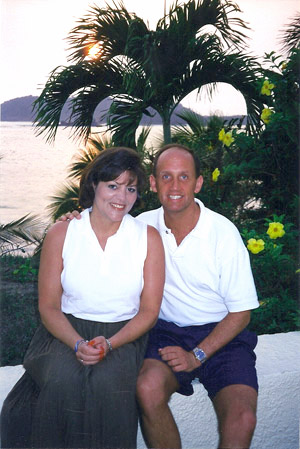 Stan and Jen Tonneson, owners of Rocky Pointe Marina
Stan and Jen Tonneson, owners of Rocky Pointe Marina
Rocky Pointe Landing, as it was known in the 1870’s, was the eastern terminus of a road that meandered through the hills between Hillsboro and Sauvie Island.
A ferry made regular trips between Sauvie Island and Rocky Pointe Landing. At that time, Rocky Pointe Landing consisted of a store, a post office, a school and sawmill. The settlement disappeared in the early 1900’s.
By the mid-1880’s the road known as “Old Lower Rocky Pointe Road” (now our main access road off Hwy 30) was deeded to Multnomah County because owners apparently could not afford to continue the high cost of maintaining the log paved road.
In the late 1920’s a rock quarry was developed by Porter-Yett Co. The Porter-Yett Co. quarried nearly all the rock for the St John’s Bridge construction site from the Rocky Pointe Landing quarry. Falling upon hard times the quarry shut down in the 1930’s. The area was used for removal of cattle during the fall and spring flooding on Sauvie Island by Rocky Pointe Livestock Co.
The late 1940’s saw the beginning of Rocky Pointe Marina as it currently exists. If you look under the ramp in the Upper Marina you will see narrow concrete stairs. These stairs led to a rickety log walk that connected what is now the marina office. There are still axe marks in the floor of the marina office next to where the woodstove was, caused from cutting kindling. Pilings were added in the 1950’s to 1980’s by owners Al Pruitt and Sig Stubbs to complete the upper section of Rocky Pointe Moorage.
In the 1970’s, the Middle Marina was developed by a maverick company known as Neptune Marine Construction Co.
The first generation of Tonneson’s acquired both the Upper and Middle Marinas in 1991. They also acquired the Kendal Lumber Co. property on the north side of the Middle Marina which was built into the Lower Marina. In 2002, the final unoccupied adjacent waterfront property just south of Rocky Pointe was purchased for future expansion. During the development in the 1990’s, a 5 acre lake was built as a dedicated Wildlife Sanctuary and named Lake Stanley for the owner’s father, Stanley C. Tonneson, who was a well known boater in the area prior to his passing in 1994.
 In 2000, the boatyard was completed which included railways over the water, a dedicated wash down pit with built in filtering, the addition of a new 35ton Marine Travelift, a 3500 sq ft shop/office and about an acre of asphalt to accommodate 30 boats on land for service.
In 2000, the boatyard was completed which included railways over the water, a dedicated wash down pit with built in filtering, the addition of a new 35ton Marine Travelift, a 3500 sq ft shop/office and about an acre of asphalt to accommodate 30 boats on land for service.
In 2006, Stan and Jen purchased the marina and boatyard from Stan’s father, Richard. Richard passed 3-10-2010. He will be missed by all.
The permit process was started in 2006 to add more floating homes & boat slips on the adjacent property. In 2014 “The Landing At Rocky Pointe” was completed adding 16 floating homes, 30 boat slips, kayak house, floating gardens, and a clubhouse with fitness room.
Rocky Pointe Marina 1991
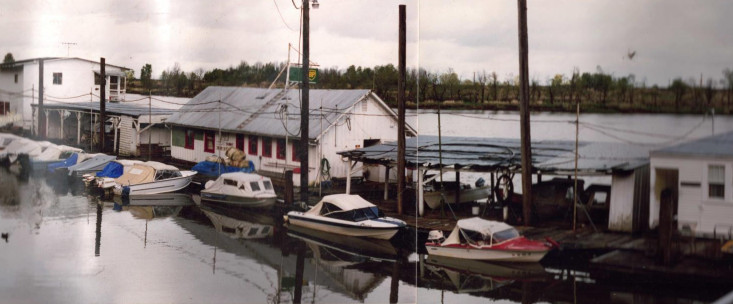
This is what Rocky Pointe Marina looked like in 1991. It had a singular walkway along the shore with small fishing boats on the inside and floating homes on the outside. Notice the white building with the red trim windows and BP Gasoline sign. That building is from the 1920’s and is our current marina office. Some of the near shore dock is still located in the middle marina.
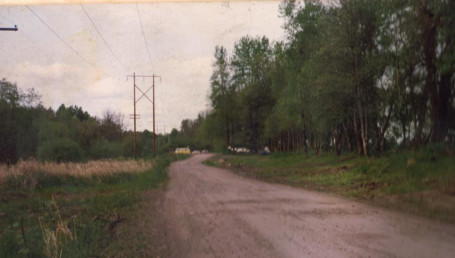 The road elevation was at about 14’ above sea level. More than 750 truckloads of fill were added to raise the elevation to about 19’ to reduce the chances of flooding. At the same time, the 5 acre lake, Lake Stanley, was created and designated a protected wetland. The grading of the road slopes 1% away from the river allowing storm water to drain over the natural bio-swale.
The road elevation was at about 14’ above sea level. More than 750 truckloads of fill were added to raise the elevation to about 19’ to reduce the chances of flooding. At the same time, the 5 acre lake, Lake Stanley, was created and designated a protected wetland. The grading of the road slopes 1% away from the river allowing storm water to drain over the natural bio-swale.
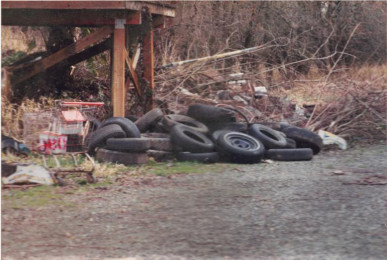 This is the water well that we still use today. The area appeared to be a dump site. The enclosed well house was built to house the treatment equipment we use today to provide your water. Our first job every day is to check the master water meter to make sure we do not have a broken water line or a house with a running toilet. Our average water use is around 4500 gallons a day for the entire facility.
This is the water well that we still use today. The area appeared to be a dump site. The enclosed well house was built to house the treatment equipment we use today to provide your water. Our first job every day is to check the master water meter to make sure we do not have a broken water line or a house with a running toilet. Our average water use is around 4500 gallons a day for the entire facility.
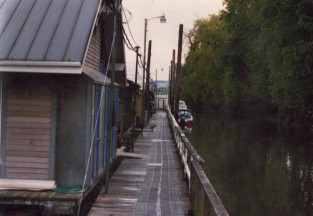 This was the original Upper Marina ramp. No way to tell how old this ramp was in 1991. There are old concrete stairs under the ramp next to the boat ramp that were probably used by the small boats after launching. That ramp was replaced with our current ramp in 2012 and is now used as our emergency ramp across from the floating gardens in the upper marina.
This was the original Upper Marina ramp. No way to tell how old this ramp was in 1991. There are old concrete stairs under the ramp next to the boat ramp that were probably used by the small boats after launching. That ramp was replaced with our current ramp in 2012 and is now used as our emergency ramp across from the floating gardens in the upper marina.
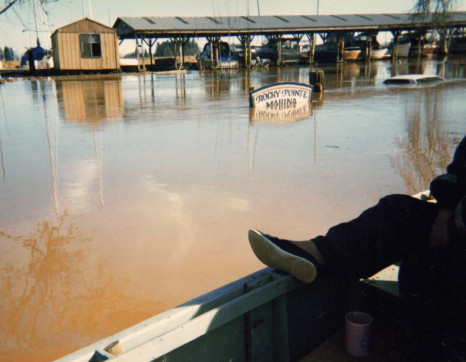 This picture was taken during the flood of 1996 when the water level reached 24.6 ft. above sea level. Notice just to the right of the Rocky Pointe sign that there is a car still parked in what is now called the gravel lot area. All the homes floated up and then back down just fine. Ramp access was cut off so residents needed to take a boat to shore and tie to the railroad tracks. There is a marker on top of a piling outside the office- “1996 Flood”
This picture was taken during the flood of 1996 when the water level reached 24.6 ft. above sea level. Notice just to the right of the Rocky Pointe sign that there is a car still parked in what is now called the gravel lot area. All the homes floated up and then back down just fine. Ramp access was cut off so residents needed to take a boat to shore and tie to the railroad tracks. There is a marker on top of a piling outside the office- “1996 Flood”
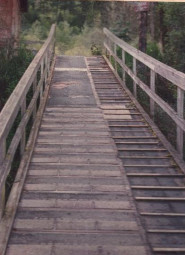 This old wood ramp was either in the middle or lower marina. When buying the marina in 1991, there were actually 2 marina properties purchased and combined to make Rocky Pointe Marina as it is today. In the 1970’s there was a boatyard called Neptune Marine where the current boatyard is. When trimming down the blackberry bushes we found many old vintage boat parts. There are still some local marinas locally with these old wood ramps.
This old wood ramp was either in the middle or lower marina. When buying the marina in 1991, there were actually 2 marina properties purchased and combined to make Rocky Pointe Marina as it is today. In the 1970’s there was a boatyard called Neptune Marine where the current boatyard is. When trimming down the blackberry bushes we found many old vintage boat parts. There are still some local marinas locally with these old wood ramps.
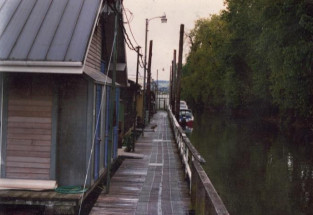 Another example of how the marina was before 1991. Notice that the pilings are all wood and the electrical wires are overhead. Starting in 1992, the marina was reconfigured to today’s layout installing all steel piling and under dock wiring. Columbia River PUD installed and owns all the primary wiring under the docks to the house meters in the original marina. In the new section of marina we had to pay and install our own wire. As part of the expansion mitigation in 2012, we were required to remove the few creosote wood pilings, cutting them at river bottom by a diver with a hydraulic chainsaw and disposing of the wood at a required landfill. There are still a couple old wood piling in the middle marina.
Another example of how the marina was before 1991. Notice that the pilings are all wood and the electrical wires are overhead. Starting in 1992, the marina was reconfigured to today’s layout installing all steel piling and under dock wiring. Columbia River PUD installed and owns all the primary wiring under the docks to the house meters in the original marina. In the new section of marina we had to pay and install our own wire. As part of the expansion mitigation in 2012, we were required to remove the few creosote wood pilings, cutting them at river bottom by a diver with a hydraulic chainsaw and disposing of the wood at a required landfill. There are still a couple old wood piling in the middle marina.
Rocky Pointe Marina 2006
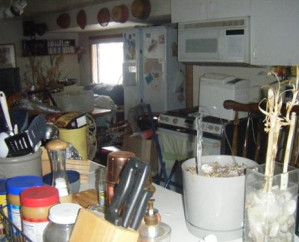 When we purchased the marina in 2006, there were 72 boats with people living on them. The total head count was well over a hundred. Each marina section had 2 full shower restrooms and laundry facilities plus the marina office also had an additional shower and laundry room. The liveaboards all walked up and down the docks in their slippers and bathrobes carrying their toiletries each morning. The parking lot was overcrowded with beat up 2nd and 3rd vehicles, some with flat tires, used to store their belongings.
When we purchased the marina in 2006, there were 72 boats with people living on them. The total head count was well over a hundred. Each marina section had 2 full shower restrooms and laundry facilities plus the marina office also had an additional shower and laundry room. The liveaboards all walked up and down the docks in their slippers and bathrobes carrying their toiletries each morning. The parking lot was overcrowded with beat up 2nd and 3rd vehicles, some with flat tires, used to store their belongings.
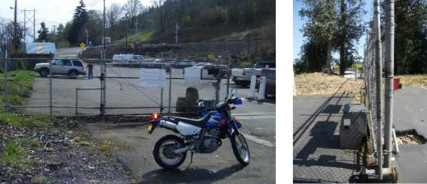
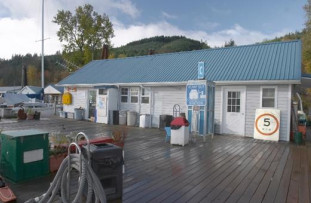 There were satellite dishes and phone wires running to many of these boats. Their docks were cluttered with their belongings and junk. Hot pots and microwaves were set up in the restrooms. There were daily and nighty dock parties on the main dock blocking access for homeowners. The marina was packed at over 100% capacity. The County Sheriffs told us stories of sting operations they held in our parking lot on a regular basis. It was set up like a low end KOA campground with a store, a coffee/hot dog stand on the fuel dock, phone booths and newspaper stands. Boats were covered with ugly tarps and makeshift canopies. There would be people at the office/store at 8am to get more cocktail ice.
There were satellite dishes and phone wires running to many of these boats. Their docks were cluttered with their belongings and junk. Hot pots and microwaves were set up in the restrooms. There were daily and nighty dock parties on the main dock blocking access for homeowners. The marina was packed at over 100% capacity. The County Sheriffs told us stories of sting operations they held in our parking lot on a regular basis. It was set up like a low end KOA campground with a store, a coffee/hot dog stand on the fuel dock, phone booths and newspaper stands. Boats were covered with ugly tarps and makeshift canopies. There would be people at the office/store at 8am to get more cocktail ice.
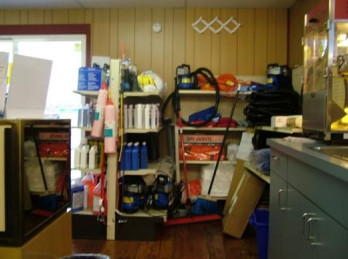
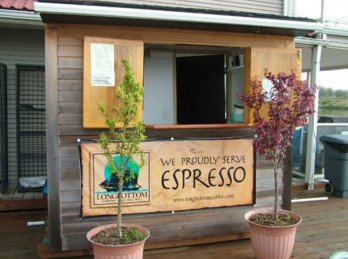
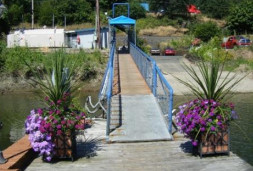 As new owners we had a vision of a much nicer marina. We decided to shift the focus of the marina to the floating home owners and create a beautiful, safe, clean and secure floating home and marina community. Over the years we got rid of the liveaboards and stopped accepting any new ones. (We currently have 2 boats left) Now it is hard to keep our slips filled to 80% but the cost is worth it (lost liveaboard revenue was near $100k per year) to provide the security and image we wish to maintain. This move has helped create a bigger demand for floating homes at Rocky Pointe increasing the home values.
As new owners we had a vision of a much nicer marina. We decided to shift the focus of the marina to the floating home owners and create a beautiful, safe, clean and secure floating home and marina community. Over the years we got rid of the liveaboards and stopped accepting any new ones. (We currently have 2 boats left) Now it is hard to keep our slips filled to 80% but the cost is worth it (lost liveaboard revenue was near $100k per year) to provide the security and image we wish to maintain. This move has helped create a bigger demand for floating homes at Rocky Pointe increasing the home values.

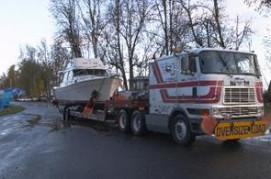 There were about 2 dozen abandoned boats both in the water and stored on land between the middle and lower marina. One by one, we obtained the boat title and disposed of the boats in a dumpster, in our burn pile, or to a new owner. We had a 45ft steel ex-military boat we towed to Zidells for scrap. There was a boat transport company operated by the boatyard which we sold immediately to keep the added truck traffic down.
There were about 2 dozen abandoned boats both in the water and stored on land between the middle and lower marina. One by one, we obtained the boat title and disposed of the boats in a dumpster, in our burn pile, or to a new owner. We had a 45ft steel ex-military boat we towed to Zidells for scrap. There was a boat transport company operated by the boatyard which we sold immediately to keep the added truck traffic down.
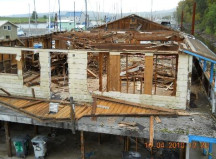
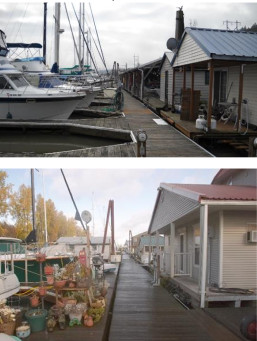 There were many houses and boathouses that had become derelict and one by one have been rebuilt or replaced over the years. There are still a few homes left that will be teardowns when the current owners leave. This 2 story house was a health and safety hazard with the float logs coming out, mold, mildew, and rot attracting rats and the belongings packed floor to ceiling. It took 3 years of legal to evict the house and another 3 years to fill the empty space after we torn the house down ourselves. That float is currently our “floating garden” in the upper marina. As landlords, we have no desire to ever evict a home, but we will do what is needed to make sure homes are safe and kept up.
There were many houses and boathouses that had become derelict and one by one have been rebuilt or replaced over the years. There are still a few homes left that will be teardowns when the current owners leave. This 2 story house was a health and safety hazard with the float logs coming out, mold, mildew, and rot attracting rats and the belongings packed floor to ceiling. It took 3 years of legal to evict the house and another 3 years to fill the empty space after we torn the house down ourselves. That float is currently our “floating garden” in the upper marina. As landlords, we have no desire to ever evict a home, but we will do what is needed to make sure homes are safe and kept up.
